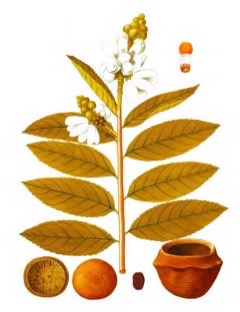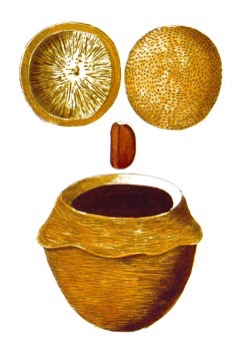 |
|
http://www.edibleplants.org |
 |
| http://www.edibleplants.org |
Translate this page:
Summary
Native to Central America and South America, Lecythis minor or Coco de Mono is a tropical woody tree. The leaves are oblong with teeth along the edge. The cream flowers form into groups at the ends of branches. The seed has an excellent flavor and usually eaten raw or roasted. It is rich in oil protein and vitamin B.
Physical Characteristics

 Lecythis minor is an evergreen Tree growing to 15 m (49ft) by 15 m (49ft) at a medium rate.
Lecythis minor is an evergreen Tree growing to 15 m (49ft) by 15 m (49ft) at a medium rate.
See above for USDA hardiness. It is hardy to UK zone 10.
Suitable for: light (sandy), medium (loamy) and heavy (clay) soils and prefers well-drained soil. Suitable pH: mildly acid, neutral and basic (mildly alkaline) soils. It cannot grow in the shade. It prefers moist soil.
UK Hardiness Map
US Hardiness Map
Synonyms
Chyrtoma valida Miers Eschweilera valida (Miers) Niedenzu Lecythis bipartita Pittier Lecythis ellipt
Plant Habitats
Edible Uses
Edible Parts: Oil Seed
Edible Uses: Oil
Seed - raw or roasted[335 ]. An excellent flavour[335 ]. The seed is rich in oil, protein and B vitamins[335 ].
References More on Edible Uses
Medicinal Uses
Plants For A Future can not take any responsibility for any adverse effects from the use of plants. Always seek advice from a professional before using a plant medicinally.
None known
References More on Medicinal Uses
The Bookshop: Edible Plant Books
Our Latest books on Perennial Plants For Food Forests and Permaculture Gardens in paperback or digital formats.

Edible Tropical Plants
Food Forest Plants for Hotter Conditions: 250+ Plants For Tropical Food Forests & Permaculture Gardens.
More

Edible Temperate Plants
Plants for Your Food Forest: 500 Plants for Temperate Food Forests & Permaculture Gardens.
More

More Books
PFAF have eight books available in paperback and digital formats. Browse the shop for more information.
Shop Now
Other Uses
Oil Wood
Other Uses We have no specific information on the wood of this species. A general description of the wood from this genus is as follows:- The heartwood is light to dark salmon; the sapwood is creamy-yellow. The texture is medium fine and uniform; the grain fairly straight or slightly interlocked; lustre is mostly low but high in some species; there is no distinctive odour or taste. The wood is reported to be very durable upon exposure to both a white-rot and a brown-rot fungus confirming its reputation for high resistance to decay; it is also highly resistant to dry-wood termites and is reported to be moderately resistant to marine borer attack. It is rated as easy to moderately difficult to air season, depending on species; a slow to rapid drying rate is reported; warp and checking ranged from slight to moderate. The wood is moderately difficult to work because of its high density; however, surfaces obtained in planing, boring, sawing, and shaping were smooth and rated as good to excellent. Silica content varies with species and dulling of cutters is also variable. The wood is used for purposes such as heavy construction, ship keels and beams, railroad crossties, industrial flooring and other uses requiring high impact resistance (wagon wheels, tool handles), turnery[316 ].
Special Uses
Carbon Farming
References More on Other Uses
Cultivation details
Management: Standard Regional Crop Staple Crop: Protein-oil
A plant of the hot, humid, tropical lowlands[335 ]. Prefers a deep, fertile soil[335 ].
Carbon Farming
-
Management: Standard
Plants grow to their standard height. Harvest fruit, seeds, or other products. Non-Destructive management systems.
-
Regional Crop
These crops have been domesticated and cultivated regionally but have not been adopted elsewhere and are typically not traded globally, Examples in this broad category include perennial cottons and many nuts and staple fruits.
-
Staple Crop: Protein-oil
(16+ percent protein, 16+ percent oil). Annuals include soybeans, peanuts, sunflower seeds. Perennials include seeds, beans, nuts, and fruits such as almond, Brazil nut, pistachio, walnut, hazel, and safou.
References Carbon Farming Information and Carbon Sequestration Information
Temperature Converter
Type a value in the Celsius field to convert the value to Fahrenheit:
Fahrenheit:
The PFAF Bookshop
Plants For A Future have a number of books available in paperback and digital form. Book titles include Edible Plants, Edible Perennials, Edible Trees,Edible Shrubs, Woodland Gardening, and Temperate Food Forest Plants. Our new book is Food Forest Plants For Hotter Conditions (Tropical and Sub-Tropical).
Shop Now
Plant Propagation
Seed -
Other Names
If available other names are mentioned here
Coco de mono - Spanish
Native Range
SOUTHERN AMERICA: Venezuela, Colombia
Weed Potential
Right plant wrong place. We are currently updating this section.
Please note that a plant may be invasive in one area but may not in your area so it's worth checking.
Conservation Status
IUCN Red List of Threatened Plants Status : This taxon has not yet been assessed

Growth: S = slow M = medium F = fast. Soil: L = light (sandy) M = medium H = heavy (clay). pH: A = acid N = neutral B = basic (alkaline). Shade: F = full shade S = semi-shade N = no shade. Moisture: D = dry M = Moist We = wet Wa = water.
Now available:
Food Forest Plants for Mediterranean Conditions
350+ Perennial Plants For Mediterranean and Drier Food Forests and Permaculture Gardens.
[Paperback and eBook]
This is the third in Plants For A Future's series of plant guides for food forests tailored to
specific climate zones. Following volumes on temperate and tropical ecosystems, this book focuses
on species suited to Mediterranean conditions—regions with hot, dry summers and cool, wet winters,
often facing the added challenge of climate change.
Read More
Expert comment
Author
Jacq.
Botanical References
Links / References
For a list of references used on this page please go here
A special thanks to Ken Fern for some of the information used on this page.
Readers comment
| Add a comment |
|
If you have important information about this plant that may help other users please add a comment or link below. Only comments or links that are felt to be directly relevant to a plant will be included. If you think a comment/link or information contained on this page is inaccurate or misleading we would welcome your feedback at [email protected]. If you have questions about a plant please use the Forum on this website as we do not have the resources to answer questions ourselves.
* Please note: the comments by website users are not necessarily those held by PFAF and may give misleading or inaccurate information.
To leave a comment please Register or login here All comments need to be approved so will not appear immediately.
|
|